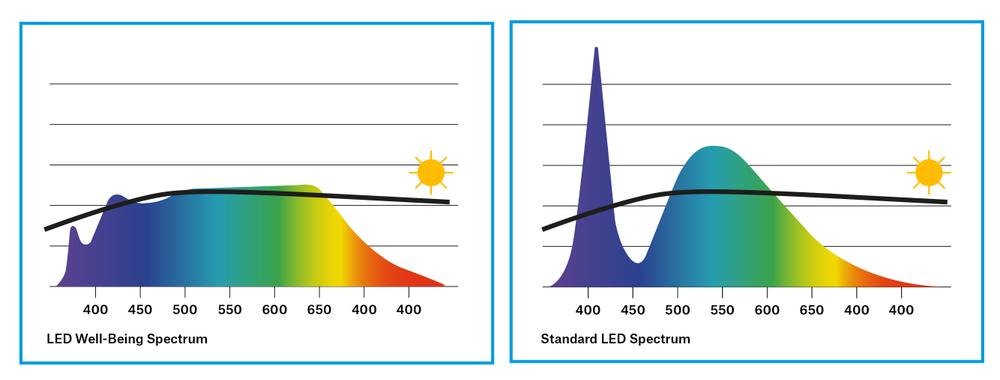Light adapted to the users' well-being
Jan 15 2020
When we talk about LED technology, we are referring to an established technology for both domestic and professional use.
So far, energy saving always comes to mind when talking about the advantages of LED technology, although it has many other remarkable features such as:
- Light output
- Very long useful life
- Reduction in maintenance costs
- Light control
- Colour rendering
Generally, these factors only refer to one dimension of lighting: photopic lighting. But how does technology change when the concept of circadian lighting is also included?
Lighting for Well-Being
To know how a correct lighting design can impact the well-being of users, it is essential to understand how the process of vision occurs from a biological perspective.
Vision occurs when the eye transforms a light stimulus into a nerve stimulus. This process involves eye cells called cones and rods, which are the basic photoreceptors found in the eye.
But vision goes beyond this transformation of stimuli to interpret images. In 1923, it was discovered that there is another type of photoreceptor cell in the retina, more complex, associated with the production of melatonin, the hormone that regulates the sleep-wake cycle. Since 2003, these cells have been known as intrinsically photosensitive retinal ganglion cells (ipRGC), and are responsible for extra-visual functions, that is, they are not related to image formation.
The ipRGC present a photosensitive pigment called melanopsin particularly sensitive to a certain emission of light in the blue spectrum (specifically to a wavelength of 480 nm) that inhibits the production of melatonin, which affects sleep-wake cycles. At this point, the concept of circadian rhythm becomes important, since it defines the changes in mental, behavioural and physical states, being light one of the main factors that triggers this process.
A circadian lighting design starts with activationupon awakening, then subsequently creates a state of alert in the early hours of the day that stimulates concentration in daily activities. As the day progresses, it should encourage relaxation, finally leading to sleep. From all this we can deduce that, by using different colour temperatures, as well as different light spectra, throughout the day, we can produce a concrete impact on the subjects' physical states and behaviours that favours natural cycles, even in artificially lit spaces.
Circadian lighting can also help restore altered biorhythm, such as people suffering from jet lag or users whose natural sleep cycle has been altered due to having to work night shifts, etc.
Dynamic lighting is the best strategy to adapt to the circadian rhythms of users. Thanks to the flexibility it provides, you can vary intensities, colour temperatures and even select the most appropriate spectral configuration to achieve the optimum effect for each moment and purpose, as is the case with Multispectral lighting.
LED Well-Being Technology
LED Well-being technology is a type of light source with a greater positive impact on people's well-being thanks to its design based on a spectral power distribution (SPD), more similar to the spectrum of natural light than standard LED technology.
To accomplish its goals, LED Well-being focuses on achieving:
- Spectral distribution similar to sunlight distribution.
- Colour Rendering Index based on the TM 30-18 methodology, offering better rendering through a greater colour palette with colours more similar to those found in the real world,
- Reduction of harmful blue light emissions (emission in the 450 nm wavelength) to eliminate fatigue, visual stress and the early onset of macular degeneration or other eye diseases,
- Increase of blue light emissions, optimal for circadian stimulation (480 nm)
In addition to light source technology, it is important to consider aspects that affect the design of the luminaire such as:
- Reducing strobe effects or flickering (anti-flicker) due to electronics
- Glare-free lighting.
Therefore, the objective of adequate lighting planning nowadays is to contemplate the different dimensions of lighting that we know of today: photopic and circadian lighting, while satisfying the visual needs of users and solving the issues affecting rest, comfort and the physical and emotional well-being of people.

